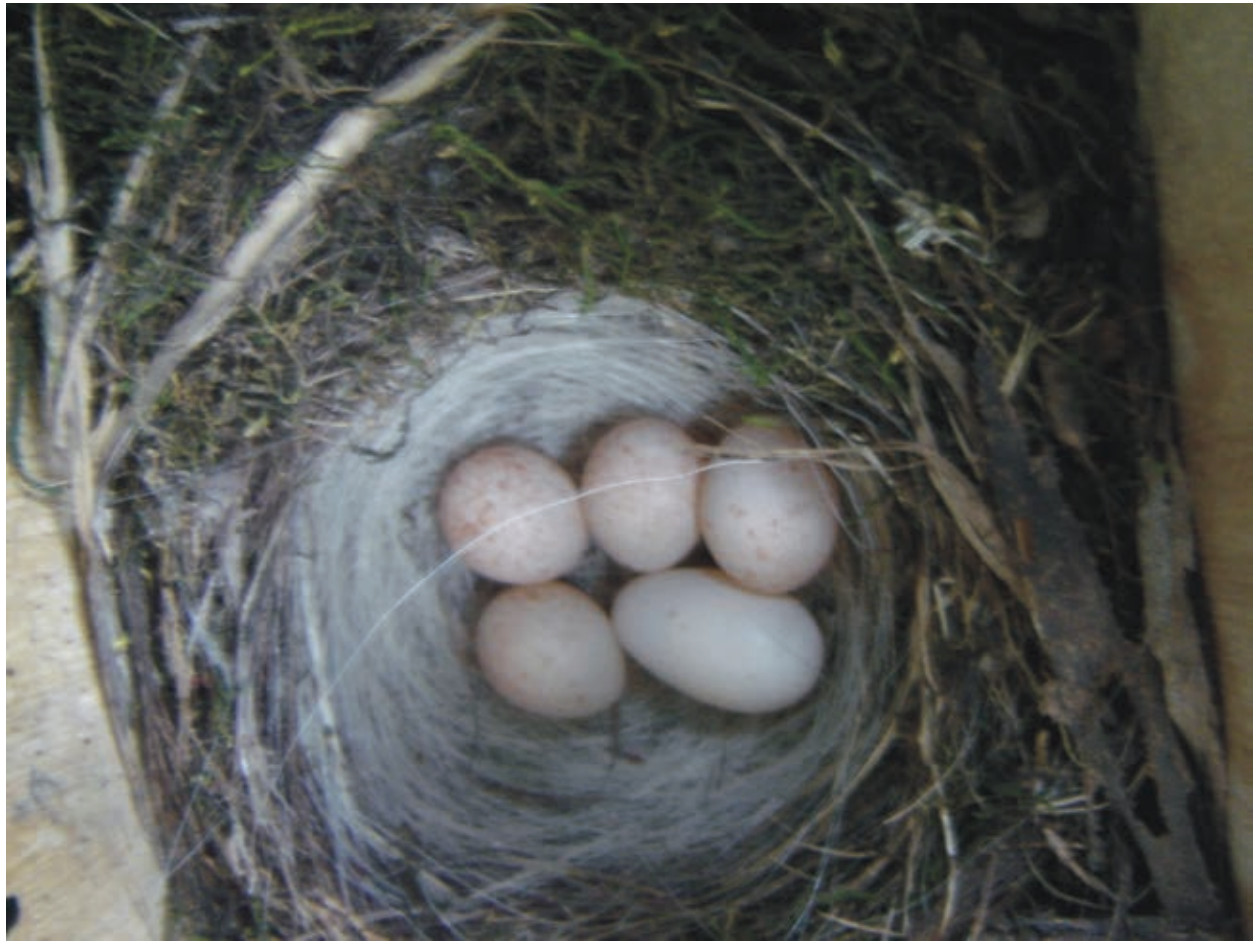
| Citation: | Wenhong DENG. 2013: Brood parasitism on the Yellow-rumped Flycatcher (Ficedula zanthopygia) by the Oriental Cuckoo (Cuculus optatus) in an artificial nestbox in Beijing. Avian Research, 4(2): 187-188. DOI: 10.5122/cbirds.2013.0018 |
The artificial nestbox on an Asian White Birch (Betula platyphylla) (1360 m in elevation) was used by a pair of Yellow-rumped Flycatcher (Ficedula zanthopygia) in Beijing, and five eggs were found in the nest in 2005. One was much larger and was identified as the Oriental Cuckoo's (Cuculus optatus) egg.
There is little information on cuckoo parasitism in flycatchers (family Muscicapidae). In Europe, the Spotted Flycatcher (Muscicapa striata), whose open nest is exploitable by the Common Cuckoo (Cuculus canorus), showed strong rejection of non-mimetic eggs, whereas the Pied Flycatcher (Ficedula hypoleuca), which nests in holes and so is inaccessible to cuckoos, showed no egg rejection (Davies and Brooke, 1998). In Japan, the Blueand-White Flycatcher (Cyanoptila cyanomelana) was parasitized by the Rufous Hawk Cuckoo (Hierococcyx hyperythrus) in five cases (Higuchi, 1998), and the Narcissus Flycatcher (Ficedula narcissina) was parasitized by both the Rufous Hawk Cuckoo (one case) and the Oriental Cuckoo (Cuculus optatus) (one case) (Higuchi, 1998). In China, the Blue-and-white Flycatcher was parasitized by the Common Cuckoo (one case), and the Lesser Cuckoo (C. poliocephalus) parasitizing the Blueand-white Flycatcher (one case) lays light cyan eggs while host eggs are white (Zheng et al., 1991; Yang et al., 2012). In India, Baker (1942) reported that the Verditer Flycatcher (Eumyias thalassinus) is a common host of the Common Cuckoo, and this cuckoo lays a highly mimetic egg in the flycatchers' nests (p. 54, plate VI). However, a recent study in southwestern China showed that the Verditer Flycatcher accepted any egg in its nest, and that it could not feed any alien nestling successfully, including those of the Common Cuckoo and the Oriental Cuckoo (Yang et al., 2013).
Here I report the first case of brood parasitism in the Yellow-rumped Flycatcher (Ficedula zanthopygia) by Oriental Cuckoo (Cuculus optatus) (Zheng, 2011) in an artificial nestbox in Beijing, China.
Since 1987, nestboxes have been put up by Beijing Normal University in Xiaolongmen National Forest Park (40°00′–40°02′N, 115°26′–115°30′E), which is at the foot of Lingshan Mountain, about 114 km from downtown Beijing, ranging from 1000 to 1700 m in elevation. Vegetation within this secondary forest (up to 50 years) area is quite diverse, and the dominant tree species included Chinese Aspen (Populus davidiana), Asian White Birch (Betula platyphylla), Mongolian Oak (Quercus mongolica), and Chinese Red Pine (Pinus tabulaeformis) (Wang et al., 2007). About 30% of the nest boxes were used by secondary cavity-nesting birds including Great Tits (Parus major), Songar Tits (P. songarus), Marsh Tits (P. palustris), Eurasian Nuthatches (Sitta europaea), Chinese Nuthatches (S. villosa), and Yellow-rumped Flycatchers. The Narcissus Flycatcher in this area seldom used small nest boxes, and its natural nests were generally open (Wang et al., 2007).
In the breeding season (May–June) of 2005, a nestbox (15 cm × 15 cm × 30 cm, with 3.5 cm in an entrance diameter) on a Asian White Birch (1360 m in elevation) was used by a pair of Yellow-rumped Flycatcher, and there were five eggs in the nest. Surprisingly, one egg was much larger and it was identified as the Oriental Cuckoo's egg (Fig. 1). Cuckoo species breeding in this forest area mainly include the Large Hawk Cuckoo (Hierococcyx sparverioides), Lesser Cuckoo and Oriental Cuckoo. Although most old and broken nestboxes could easily be opened by the wind, it was still unclear how the cuckoo laid its egg in the nestbox. Given that the Common Cuckoo can readily parasitize the European Redstart (Phoenicurus phoenicurus) even when breeding in small holes (Rutila et al., 2002), I assume that the cuckoo must have entered the box. The eggs of the host were not broken, so it is unlikely that the Oriental Cuckoo laid the eggs through the hole in the box. This constitutes the first case of brood parasitism in the Yellowrumped Flycatcher by the Oriental Cuckoo. The female flycatcher was incubating when the nestbox was found. Unfortunately, I did not monitor the nest later, thus did not know whether the host reared the chick or not.
I am grateful to Zhengwang Zhang, Jie Song and Yanyun Zhang for their help with fieldwork. Wei Liang and Canchao Yang kindly help with cuckoo species identification. I would like to thank Anders Pape Møller for helpful comments on an early version of this manuscript.
|
Baker ECS. 1942. Cuckoo Problems. H. F. and G. Witherby, London.
|
|
Davies NB, Brooke MdL. 1998. Cuckoos versus hosts: experimental evidence for coevolution. In: Rothstein SI, Robinson SK (eds) Parasitic Birds and Their Hosts. Oxford University Press, Oxford, pp 59–79.
|
|
Higuchi H. 1998. Host use and egg color of Japanese cuckoos. In: Rothstein SI, Robinson SK (eds) Parasitic Birds and Their Hosts. Oxford University Press, Oxford, pp 80–93.
|
|
Yang C, Stokke BG, Antonov A, Cai Y, Shi S, Moksnes A, Røskaft E, Møller AP, Liang W, Grim T. 2013. Host selection in parasitic birds: are open-cup nesting insectivorous passerines always suitable cuckoo hosts? J Avian Biol, 44: 216–210.
|
|
Wang N, Zhang Y, Zheng G. 2007. Nest and nest-site of Narcissus Flycatcher in Xiaolongmen Forestry, Beijing. Zool Res, 28: 337–343.
|
|
Zheng G. 2011. A Checklist on the Classification and Distribution of the Birds of China. 2nd edn. Science Press, Beijing, p 118.
|
|
Zheng Z, Xian Y, Guan G. 1991. Fauna Sinica - Aves. Vol. 6. Science Press, Beijing, pp 98–115.
|